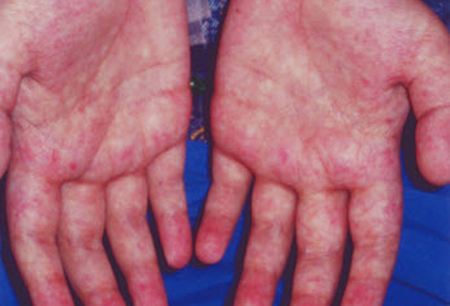History and exam
Key diagnostic factors
common
presence of risk factors
Factors that may increase the likelihood of acute graft-versus host disease (GVHD) include: human leukocyte antigen mismatch, older age of recipient or donor, donor and recipient gender disparity (particularly a female donor with a male recipient), parous female donor, type and stage of the underlying malignant condition, transplant conditioning regimen intensity, absent or suboptimal GVHD prophylaxis.
Factors that may increase the likelihood of chronic GVHD include: prior acute GVHD, older age of recipient or donor, female donor with male recipient, parous female donor, use of peripheral blood stem cells, donor lymphocyte infusion.
allogeneic haematopoietic cell transplantation (HCT) recipient
Graft-versus-host disease (GVHD) occurs in the setting of allogeneic haematopoietic cell transplant.
Distinguishing between acute and chronic GVHD depends on characteristic clinical manifestations and symptoms, and timing post-transplant.[1]
new-onset painful mouth sores
The specific presence of lichen planus-like lesions in the mouth is a diagnostic feature of chronic graft-versus-host disease.[1]
hyperpigmented skin lesions
The specific presence of poikiloderma and other skin features that are lichen planus-like, sclerotic, morphea-like, or lichen sclerosus-like are diagnostic features of chronic graft-versus-host disease.[1]
Generally, skin and mouth are the most commonly involved sites.
diffuse maculopapular rash
Maculopapular rash is one of the presenting clinical signs of acute skin graft-versus-host disease.
In severe cases (stage 4), the skin may blister and ulcerate.[Figure caption and citation for the preceding image starts]: Acute graft-versus-host disease (GVHD) of the skin (grade I)Courtesy of Dr John Levine, Professor, Blood and Marrow Transplantation Program, University of Michigan; used with permission [Citation ends].
genital signs and symptoms
Genital manifestations of chronic graft-versus-host disease include: lichenoid features, vaginal scarring or clitoral/labial agglutination, phimosis or urethral/meatus scarring or stenosis.[1]
nausea, vomiting, abdominal pain, profuse diarrhoea, and anorexia
Classic gastrointestinal (GI) symptoms suggestive of acute GI graft-versus-host disease.
Other diagnostic factors
common
joint stiffness or tightness
Joint stiffness and contractures secondary to fasciitis or sclerosis are diagnostic features of chronic graft-versus-host disease.[1]
day +21 to day +25 after HCT
Median onset of acute graft-versus-host disease ranges between 21 and 25 days after transplantation.
dry, gritty, and painful eyes
Manifestation of chronic graft-versus-host disease (GVHD).
Schirmer test can measure the degree of tear formation by the lacrimal glands. The test may be useful to monitor chronic GVHD and can be performed routinely in the office.
uncommon
jaundice
Jaundice is a sign of liver graft-versus-host disease (GVHD).
Jaundice can also be commonly seen in other causes of liver dysfunction following haematopoietic cell transplantation (HCT), such as veno-occlusive disease/sinusoidal obstructive syndrome, drug toxicity, viral infection, sepsis, total parenteral nutrition cholestasis, or iron overload.
hepatomegaly
May be noted in some patients with liver graft-versus-host disease.
scleroderma
Sclerodermatous features are considered a high-risk feature in chronic graft-versus-host disease.
May involve the skin, muscles, fascia, and joints.[1]
Risk factors
strong
HLA mismatch and unrelated donor
Human leukocyte antigen (HLA) mismatch is the greatest risk factor for acute GVHD. The greater the degree of HLA mismatch, regardless of the type, the higher the likelihood of developing acute GVHD.[31][48][49][50]
Incompatibility for HLA-A and HLA-C alleles between the donor and recipient of haematopoietic stem cells have been shown to be strong risk factors for the development of severe acute GVHD.[50][51]
Analysis of US National Marrow Donor Program (NMDP) data from 3857 allogeneic haematopoietic cell transplants between 1988 and 2003 found that high-resolution DNA matching for HLA-A, -B, -C, and -DRB1 (8/8 match) was the minimum level of matching associated with the highest survival. A single mismatch at HLA-A, -B, -C or -DRB1 (7/8 match) was associated with higher mortality.[52]
The risk of developing acute GVHD following an unrelated donor transplant ranges from 60% to 80% depending on the human leukocyte antigen (HLA) mismatch.[53][54]
The risk of developing chronic GVHD is 60% to 70% in recipients of mismatched haematopoietic cells or haematopoietic cells from an unrelated donor.[21]
The US National Marrow Donor Program and the Center for International Blood and Marrow Transplant provide matching guidelines and typing strategies for unrelated adult donor and cord blood selection.[55]
prior acute GVHD
recipient or donor in older age group
female donor with male recipient
parous female donor
type and stage of underlying malignant condition
Patients with chronic myeloid leukaemia have a greater relative risk for developing grade II to IV acute GVHD compared with patients with acute myeloid leukaemia or acute lymphoblastic leukaemia patients.[24]
Advanced malignant disease has been associated with increased risk for developing acute GVHD.[23]
high-intensity conditioning radiation regimen
peripheral blood stem cell transplant
Significantly higher incidence of chronic GVHD has been reported with peripheral blood stem cell transplantation than with bone marrow transplantation (53% vs. 41%) in one randomised controlled trial of patients undergoing allogeneic transplant from unrelated donors.[42]
donor lymphocyte infusion (DLI)
absent or suboptimal GVHD prophylaxis
weak
white or black race
cytomegalovirus (CMV) seropositive
splenectomy
low performance status score
Poor performance status has been found to correlate with increased risk for acute GVHD.[24]
low socio-economic status
Low socio-economic status has been associated with increased rates of acute and chronic GVHD, increased transplant-related complications within the first 100 days post haematopoietic cell transplant, and decreased overall survival.[38]
Use of this content is subject to our disclaimer